How Agents and Investors Can Generate Leads In A Purposeful, Sustainable, and Scalable Way in their New and Growing Businesses
Where do you start when it’s time to plan your real estate lead generation?
If you’ve ever seen a fellow real estate professional say their ENTIRE marketing strategy is JUST Facebook Ads, JUST webinar leads, or JUST any one thing that leaves you scratching your head because you’ve tried it yourself and never got consistent results, I understand.
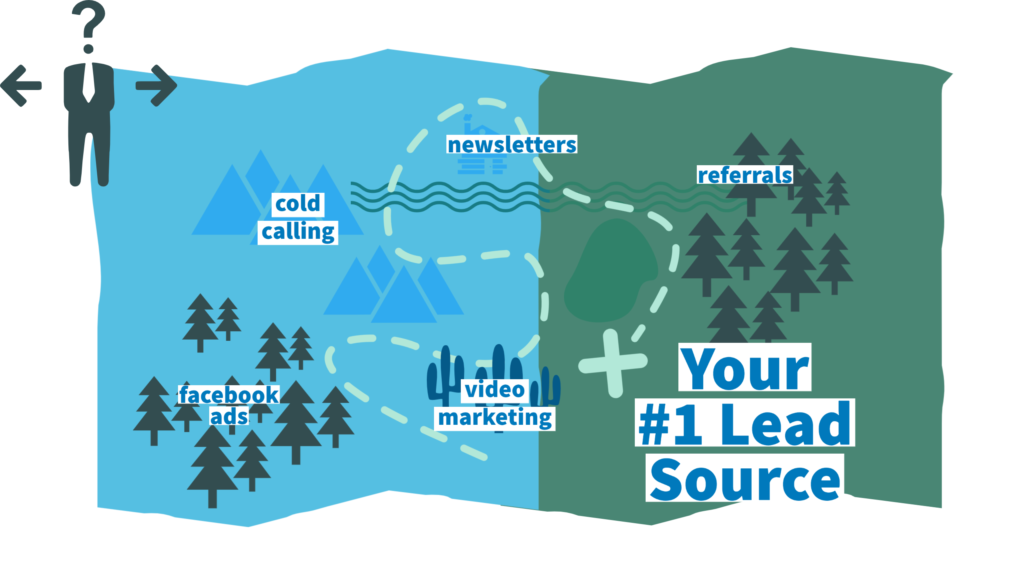
I’ve been there, too.
I wanted to understand why my lead generation was like a fire I couldn’t keep lit without burning through bottle after bottle of lighter fluid.
Eventually, I got it right. When it happened, I was running a real estate call center and had to start fielding sales demos myself while we recruited new sales agents – but that’s a story for another day.
In any case, I didn’t realize what exactly I’d gotten right.
Back then, I chalked it up to good luck, coincidence, or who knows what.
Flash forward to today:
Whenever I see a social post asking, “what’s your #1 lead source?” Or “how do you generate leads?” I stop and read all of the replies.
When I’m listening to podcasts where someone is sharing their success story, I pay extra close attention to every detail they share about their lead generation process.
And I don’t do this because I’m making an ever-growing list of all the things every business owner should be doing all the time, every second, to generate leads for their business…
What I’ve noticed is that – time and time again – the people that are consistent in their lead generation fit into two categories:
- They have big budgets and have scaled their business to sustain lead generation across multiple channels.
OR
- They have a marketing strategy that is highly focused, intentional, and tacitly executed.
An aspiring entrepreneur working solo or as a small team likely doesn’t fit into category one.
It’s category two where people who get it right all start. I had unknowingly put myself in that category with the call center when I quit trying to wear a dozen hats and simply focused on one thing: Making real estate memes to make my target audience laugh, as close to daily as possible.
That was my thing, and as soon as I got consistent and focused, it all just started working.
That experience led me to the realization that marketing does not need to require exhaustive chaos, and from there I began my journey towards marketing mastery.
If you’ve made it this far, I want to help shorten your learning curve and get you excited about your marketing strategy! So here are my tips for consistent lead generation that require neither a giant budget nor juggling 80 tasks at once.
1) Brainstorm all the marketing channels you’d like to use in your lead generation
Start broad: Think about all of the channels – direct mail, cold calling, social media marketing, etc… – you’d like to incorporate in your marketing eventually.
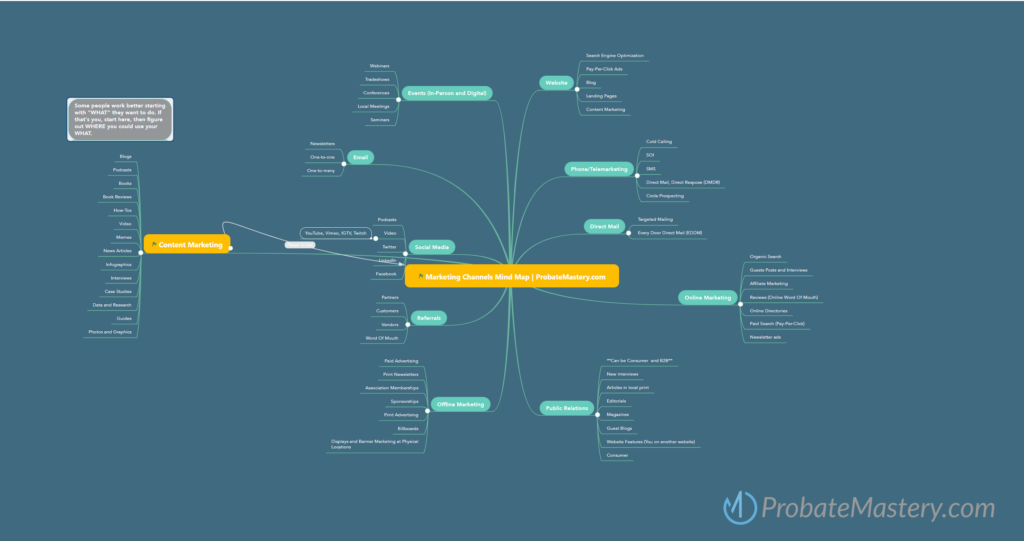

To help get you started, I made a downloadable mind map of 51+ different marketing channels for lead generation! There’s something for everyone:
As you consider different marketing channels, brainstorm the associated tasks required to successfully implement and maintain consistent lead generation through it.
This is just a brainstorming activity, but the purpose is two-fold:
- To shake the urge to do-it-all out of your system (I mean, look at how giant that mind map is!); and
- To give you a starting point for an actionable and realistic strategy.
2) Pick your #1 priority marketing channel and commit to it.
After looking at the mindmap, what marketing channel are you most drawn to? What would you enjoy committing time to right now, consistently, to build momentum for the next 3-6-9 months? Are you willing to research and learn tips, tricks, and strategies for learning that channel?
The point is, pick a marketing channel you are willing to learn about and work in. This is what you’ll commit the bulk of your lead generation efforts to, after all.
You might be wondering – “But what about all the other marketing channels?! Don’t I NEED to have them all?!”
The thought of trying to juggle it all reminds me of the infamous Cake Scene from Matilda, where Brucey eats a giant chocolate cake by himself just to pass out.
A great way to deal with the urge to do it all without overextending yourself is to slice the cake now and save the extra pieces for later. Commit one block of time to set up (or update) your accounts, basic information, and basic branding on the marketing channels you want to have rocking-and-rolling eventually.
Then, block off time at regular intervals to revisit and refresh these channels at a cadence that makes sense for your business (once a week, month, or quarter).
For example, if you’re choosing outbound cold-calling as your priority lead generation strategy, go ahead and set up your social media profiles (Facebook, Instagram, YouTube, etc..), an email platform with custom signatures and canned responses for common correspondence, and so on.
The purpose here is to be able to use each of your non-priority platforms when convenient and/or necessary, without fragmenting your focus and spreading yourself so thin that you lose consistency in your lead gen.
3) Know the audience for your marketing channel, and build a strategy around that audience.
Getting the wrong engagement from your marketing efforts can be just as frustrating as getting little to no engagement at all.

The best way to avoid both of these problems is to know the audience you’re targeting with any given marketing pathway.
For the marketing strategy that you’re committing to today (do you like my assumptive close on your future success? I do) to perform optimally, you need to identify and understand your target audience.
You’ve probably given some thought to who your target audience is before, but breaking the barrier to consistent lead generation means getting more specific in how you define your audience for each specific marketing plan. So let’s take a few moments to consider who you want to get your marketing message in front of a little more granularly:
- Who are they?
- What problems and questions do they have?
- When and where you can find them?
- How are your services valuable to them? More specifically, what parts, facets, and characteristics of your business are particularly relevant to who they are and what they need and want?
- How does your choice of marketing channel impact the interaction between your marketing and your intended audience?
To make contact during cold calling, you must have correct numbers, the intended contact has to answer the phone, and you both have to be willing to speak. With Instagram, you must have graphics, and for YouTube you must have Video. For Direct Mail, you must pay postage per marketing piece, per recipient, and multiple touches may be required to make a meaningful impression.
Always consider the characteristics and use-cases of a marketing channel as it relates to your lead generation strategy. Your audience will look different from channel to channel, and the more deliberate you are about your marketing efforts within the channel-audience context, the better your results will be.
4) Decide what you can streamline, template, and automate in your primary lead generation strategy.
Getting consistent is one thing, but staying consistent is another. If you want to stay consistent in your lead generation when your marketing efforts start bringing in results, this is the most important step of this entire guide.
When you send a few emails here and there, answer a text or two as they come in, post on social media when you’re bored or feel like it…. Streamlining doesn’t seem as necessary or impactful.
But as you focus on your marketing implementation, consistency can feel like repetition. Feeling like you’re doing the same thing over and over, especially when results can take time to come to fruition, can quickly derail your motivation.
When you feel like you’re doing the same thing over and over, you’re getting bored, or feel like being consistent is futile, ask yourself every time:
“What can I do to make this simpler?”
When you feel like you’re doing the same thing over and over, you’re getting bored, or feel like being consistent is futile, ask yourself every time:
“What can I do to make this simpler?”
One trick for me when I was posting real estate memes on Instagram was adding a few sets of hashtags to my phone’s keyboard for copy-and-pasting. I had never considered this for casual posting, as casual posting didn’t feel tiresome or time-consuming. But all of a sudden I was posting several memes a day, every day, while still managing my regular workload. Something I enjoyed doing was becoming a chore, and my daily workload was starting to take longer and longer.
In situations like this, you have to stop and purposefully ask yourself what can help reduce or eliminate unnecessary steps. And you must recognize that even small time-wasters add up when you do them consistently and leave them unchecked. If I posted 3 memes a day for 60 days and spent one minute manually hashtagging each one, that’d be 3 hours! That’s 18 hours a year! Who would want to spend 18 hours this year writing hashtags?!
There are tasks like this in every marketing strategy, I promise.
You will inevitably run into something that feels a bit more dreadful the more you do it, and it’s natural for your brain to shut off any willpower to do things that feel wasteful and inefficient.
This is why people get the ball rolling for a week or two but stop as soon as they get consistent, right before the lead generation has a chance to take off.
But the good news is that any task that makes you feel like you’re doing the same thing over and over can almost always be templated, automated, and streamlined.
Quickly recognizing when a task kills your vibe is key to protecting all the momentum you started out the gates with.
As you commit to getting consistent in your marketing, the best thing you can do for yourself and your marketing efforts is to commit to being proactive in recognizing repetitive tasks and taking action to streamline them.
Set aside 15 minutes at the beginning of the week to reflect on your tasks and re-evaluate any tasks that might be grinding your gears in the wrong direction.
5) Set goals and choose metrics to measure progress.
In the previous tip, we touched on the relationship between tasks and our willingness to do them.
Sometimes, that relationship couldn’t be better! We LOVE doing X and we have no problem doing X all day, every day! It’s the most consistent thing we’ve ever done!
But what of those marketing tasks aren’t generating leads for your business when all is said and one?
Now, something you truly enjoy doing seems like a complete waste. Your dream of loving your work is one foot out the door.
“I can’t make money doing this. I can’t believe I just wasted 3 months for nothing…”
It’s important to take an objective look at your marketing efforts at regular intervals.
I’m writing this article because any marketing channel you see working for someone else can work for you. I don’t think any metrics can convince me “Yeah, Reader, you know I think you might be right that Facebook just doesn’t work….” or “Yeah, you know, cold-calling just doesn’t work…” and so on.
But things won’t work if you don’t take care to define a goal, measure performance, and make adjustments regularly.
Get consistent in measuring the results of your lead generation efforts – even if it’s just for 5 minutes a week.
6) Consider getting an accountability partner.
Having an accountability partner isn’t just a reason to work towards your commitments; it also means an extra set of eyes for proofreading copy, extra ears for relevant news and updates, extra hands for shared tasks, and an extra brain to bounce ideas off of.
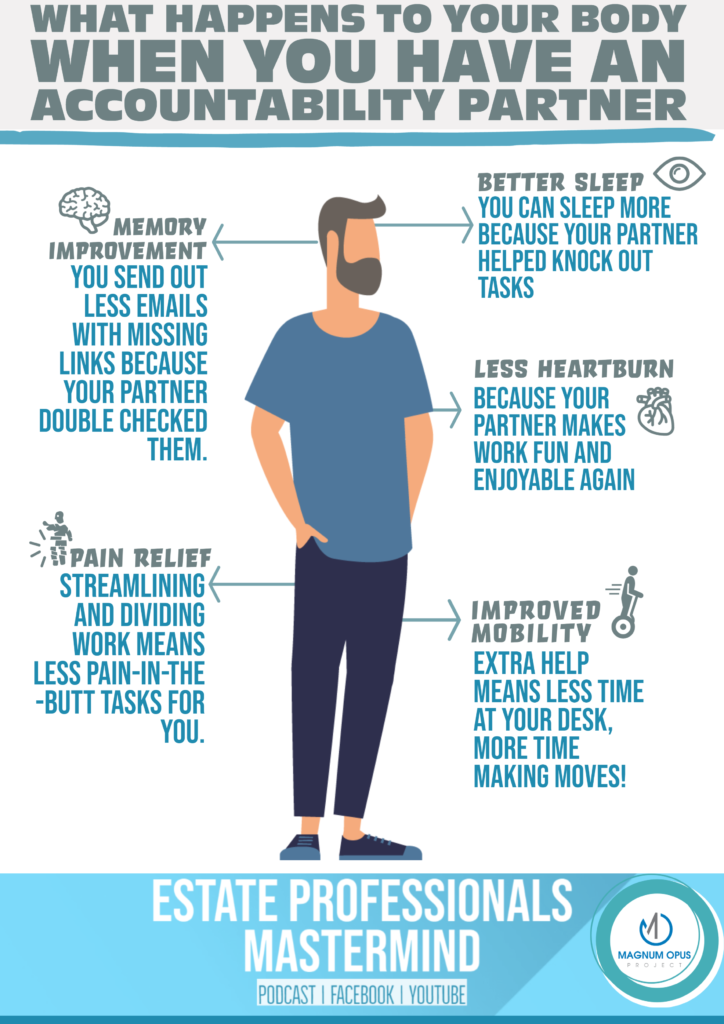
The arrangement between you and your accountability partner can be as collaborative or mutually exclusive as you both would like. Producing content together, especially if you’re able to share branding (i.e. you’re on the same team) or co-brand if you’re working as vendor partners, can boost productivity and content value-adds.
If you’re wary of working with a partner on marketing because you don’t want to share accounts or work under the same brand, there are still so many ways having an accountability partner can help you keep your lead generation consistent. You can create and share unbranded marketing assets and simply add your branding later. This is ideal for accountability partners with the same marketing goals, but who work in different markets (where audiences won’t see the same content from two different brands).
Some tasks where two are better than one:
- Creating Social Posts. If you’re working on the same team and share channels, one person might create the content and the other might handle publication and engagement on the publishing platform. For partners working with different channels, one person could create graphics while the other writes copy; both review each other’s work with suggestions, and in the end, you’ll have a gallery you can pull content from at the ready.
- Cold Calling. Whenever one of our ISAs hit a rut in their outbound appointment-setting, the team would step in to get an appointment from that list. It was invigorating and reciprocal, and honestly, everyone always jumped at the chance to call someone else’s list over calling the one they were assigned to themselves. Sometimes it’s just easier, more natural, and more empowering to endorse your partner. It’s a great way for two people to commit to cold calling, and make sure neither person gets stuck in a rut for too long.
- Direct Mail. This one is plain and simple. You have two people to write templates, two people to proofread, and two people to send and share results. It’s hard not to complete a draft or revisions when someone else is waiting to share feedback. Not only will you be more accountable for getting the task done, but you’ll also be accountable for tracking results and finding places for improvement.
There are ways to get creative in partnering with others for productivity and accountability. It’s even possible to perform optimally as a small group of 3-5 people if you’d like to add more than one partner to the mix!
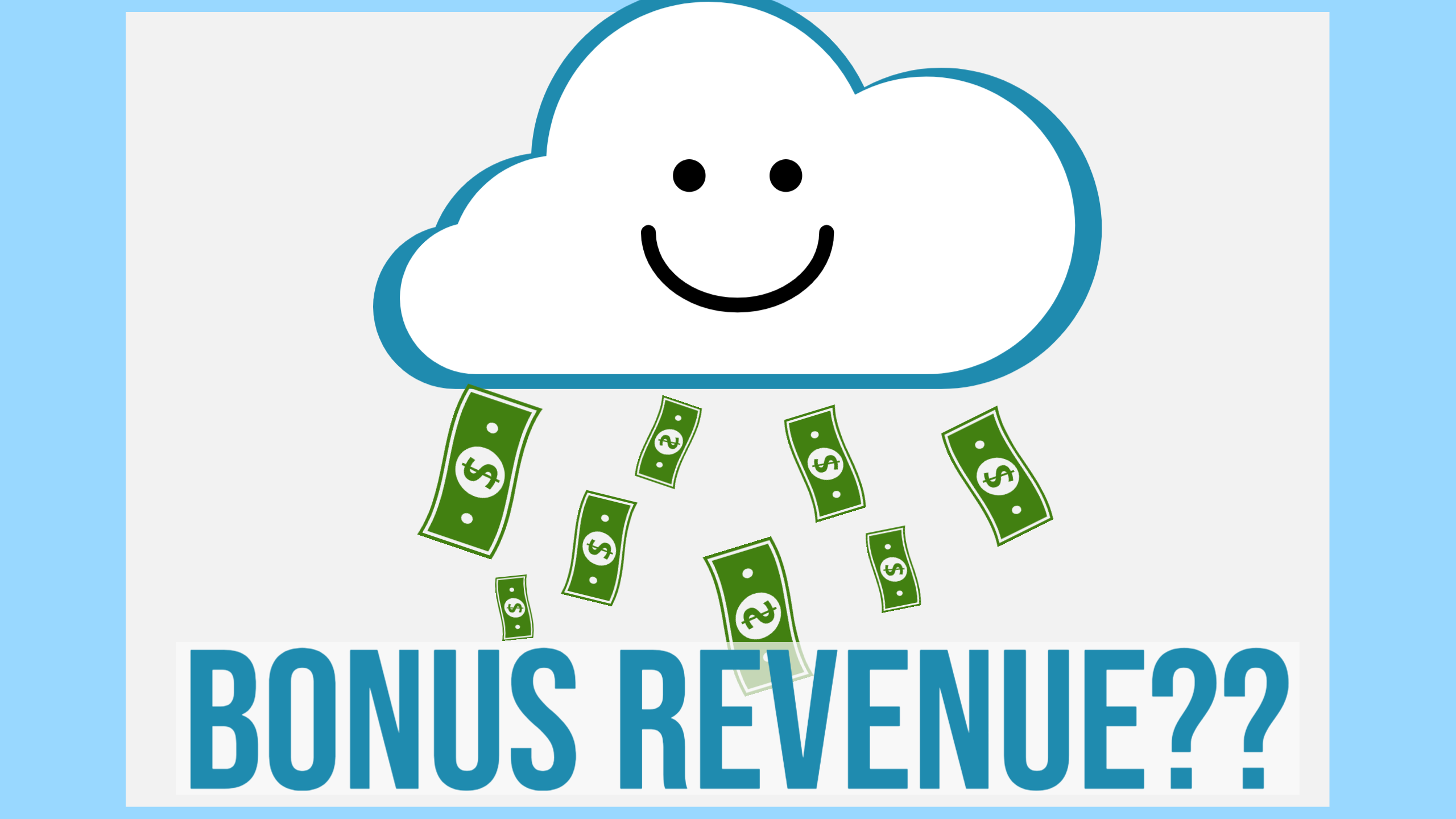
Generate Additional Income With The Content You’re Already Creating: If you and your accountability partner are creating unbranded marketing assets, why not take your collection of social posts, email templates, and anything else you’ve created and sell them as digital products to other real estate professionals?
7) Document what works so you can prepare to delegate
In step one, we picked a #1 priority for right now. Once you’ve achieved consistent lead generation through one channel, can:
- Handoff your marketing so you can focus on nurturing and closing deals
- Scale those marketing efforts by hiring additional help to repeat the same process
- Start building up consistent lead generation through a different marketing channel
Documenting your processes will enable you to accomplish any of the above pathways much more easily and effectively. Document what worked, what didn’t work, what ideas you didn’t get to try, what parts and pieces are involved, and any relevant brand guidelines.
This is just a simple housekeeping task – but it’s vitally important if you want to scale your business successfully.
Time To Take Action
When your marketing efforts are structured, enjoyable, and manageable, consistent lead generation gets easier to achieve and easier to scale. So, let’s hit the ground running.
- Save the marketing channel mindmap for future reference.
- Block off a time on your calendar to walk through these 7 steps.
- Join Estate Professionals Mastermind on Facebook to discuss strategies and find accountability partners
- Get inspired with this group coaching session that focuses on getting consistent in your lead generation – Bill Gross shares his top 3 lead generation strategies that took him from zero production to semi-retired!
- And lastly, commit to treating lead generation as a process; if you feel overwhelmed, step back to the drawing board and figure out what pieces you can focus on.
You’ve got this!

One Comment on “7 Real Estate Lead Generation Tips for Solo Agents/Small Teams”
Amazing post. I used a very similar process to plan out my program, and that is responsible for the success I have had